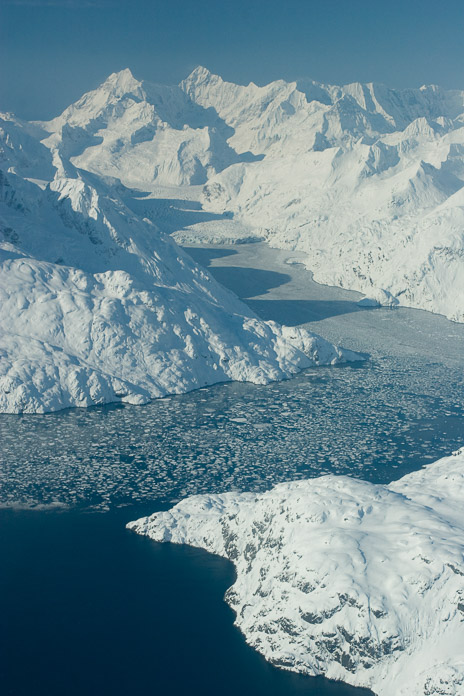
这个Johns Hopkins Inlet(约翰斯·霍普金斯湾)的航拍镜头是在Glacier Bay(冰川湾)仍处于严冬时拍摄的。在这里,你看到的沿着峡湾往下流的大多数冰是“饼状冰”,而不是冰川的巨型冰块。正如你从长长的影子可以看出的,冬天的太阳在地平线上的运行轨迹很低,这也就意味着与其他季节相比,只有较少的阳光可以抵达水面。在这里,一层淡水停留在深得多的密度较大的盐水顶部。这一层淡水常常在阴影里,所以冻得很结实。然而,随着潮汐涨落,海平面在仅仅六个小时内就可以上下变化20英尺(6米)甚至更多。这将表面的“饼状”冰打碎,接着冰块沿着唯一的方向流动,朝着湾外流。
Esta vista aérea de la ensenada Johns Hopkins fue tomada cuando el invierno aún se aferraba firmemente a Glacier Bay. El hielo que se ve fluyendo por el fiordo son principalmente “placas de hielo”, más que icebergs glaciares. Como se puede apreciar por las largas sombras, la trayectoria del sol en invierno es baja, lo que significa que muy poca luz llega a la superficie del agua. Aquí, una capa de agua dulce reposa sobre aguas saladas mucho más profundas y densas. Esta capa de agua dulce que está constantemente en las sombras, se congela. Sin embargo, al subir y bajar las mareas, el nivel del mar puede cambiar hasta en veinte pies (6 m.) o más, en sólo seis horas. Esto rompe las 'placas' de hielo de la superficie, y éste fluye en la única dirección posible, fuera de la ensenada.
This aerial shot of Johns Hopkins Inlet was taken while winter still grasped a firm hold on Glacier Bay. Here, the ice that you see flowing down the fjord is mostly ‘pan ice’ rather than glacial icebergs. As you can see from the long shadows, the winter sun tracks low across the horizon in the winter, which means that relatively little sunlight reaches the surface of the water. Here, a layer of freshwater rests on top of a much deeper body of denser saltwater. This layer of freshwater, constantly in the shadows, freezes solid. However, as the tides ebb and flow, the level of the sea can shift by as much as twenty feet or more in only six hours. This breaks up the ‘pan’ of ice on the surface, and the ice flows in the only direction it can, out of the inlet. Photographer: Sean Neilson